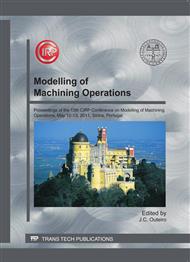p.764
p.774
p.784
p.794
p.804
p.813
p.821
p.826
p.839
Machinability Evaluation in the Ultrasonic Drilling (USD) Process of Aluminum Oxide-based Ceramics
Abstract:
The ultrasonic drilling (USD) has been used in the manufacture of the hard, fragile, difficult to cut, nonconductive ceramic materials. In this study, the mathematical models of material removal rate (MRR) and surface roughness (SR) have been obtained for the machinability evaluation in the USD process of aluminum oxide-based ceramic material. The experimental plan adopts the face centered central composite design (CCD). The mathematical models using the response surface methodology (RSM) are developed so as to investigate the influences of three machining parameters, including the power rating, grit size and slurry concentration on the performance characteristics of MRR and SR. It has been proved that the proposed mathematical models in this study would fit and predict values of the performance characteristics, which would be close to the readings recorded in experiment with a 95% confidence level. The significant parameters that critically affect the performance characteristics are examined.
Info:
Periodical:
Pages:
804-812
Citation:
Online since:
April 2011
Authors:
Price:
Сopyright:
© 2011 Trans Tech Publications Ltd. All Rights Reserved
Share:
Citation:


